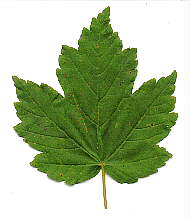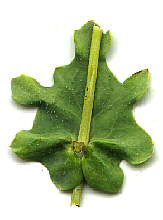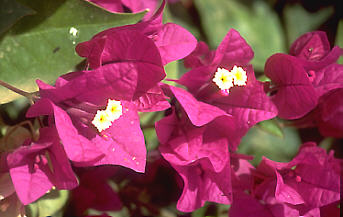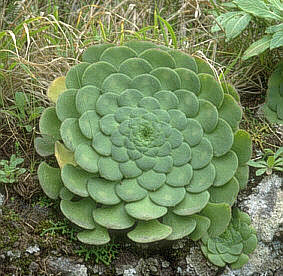|
|
|
 Selected by the SciLinks program, a service of National Science Teachers Association. Copyright 2001. |
A leaf is an aerial and lateral outgrowth of the stem of a usually flat and dorsiventral anatomy. It functions mainly to manufacture food by photosynthesis and consists typically of a stalk also called petiole, a flattened blade, the lamina, and the leaf base. Strands of conducting and strengthening tissues, the veins, run through it. Their pattern, also called leaf venation, is a feature of characterization. Leaves may be simple, i.e. undivided or compound (composed of several parts called leaflets). The blade margin and the leaf arrangement at the stem are further features of characterization.

While potentially unlimited growth is a feature of the shoot, that
of leaves is usually limited. They are almost always flat and have a
dorsiventral anatomy , i.e. their
upper and their undersurface are constructed differently and have
different functions. This morphological and anatomical peculiarity is
strongly connected to the main function of leaves,
photosynthesis. With most
conifers, the leaves are very thin and often tough (needles).

A typical leaf is organized into blade (lamina), stalk or petiole and leaf base. In some plant species, the leaf base is plainly set off against the petiole while the transition is invisible in others. Sometimes, it is merely indicated by a faint widening. Occasionally, lateral excrescences develop. Most species have clearly recognizable petioles. If they are missing, the leaves are said to be sessile in which case the leaf base may sometimes surround the shoot.
The extremes are laminas with fused basal rims evoking the impression of a leave that the shoot grows through (Claytonia perfoliata). The basis of the leaf stalk may even grow down on the shoot a little bit further. With many monocots, like Poaceae or Graminaceae, the shoot is completely surrounded by a sheath-forming petiole.
The blade is radiated by leaf
veins that contain the fibres. It is distinguished between
parallel, arched, pinnated or netlike vein structures.

Just as variable as the vein structure is the shape of the leaves. The fundamental difference is that between simple and compound leaves. The compound leaves are built from several small leaves or from pinnations that sit in a regular organisation at the undivided or branched rhachis.
Cataphylls are simply
organized, scale-like leaves. They can be found at the sprout, at the
basis of sprouting shoots or underneath the normal leaves and in
wooden plants also as a protection for the buds.

Finally, bracts have to be mentioned that live above the region of the usual leaves, for example at the inflorescence as subtending bracts for the flowers. But they can also have very different functions. Remarkable are the strikingly colored bracts of Bougainvillea spectabilis and Poinsettia pulcherrima (poinsettia) that add strongly to the attractivity of the rather inconspicuous flowers. Another example are the Cuckoo-pint and its relatives where the bract encloses the inflorescence and is at the same time a refined trap for pollinating insects (Arum maculatum).
Some species, especially those that live in water have differently shaped leaves (heterophylly). An example is Ranunculus aquatilis (water crowfoot) which has pinnation-shaped, submerse living leaves and flat swimming leaves.
Another feature of recognition is the blade margin that can be shaped very differently. It can be plain, serrated, double serrated, crenated or sinuated. Leaves with deep clefts are called pinnatified, pectinated, palmated or lobed.
Quite a few species have structures called leaf metamorphosis (variations), because they are homologous to leaves. Among these are thorns where the moulding of the blade does not occur and the leaf veins have been strengthened by the deposit of a though material, as well as leaf tendrils that also miss the lamina but have an extremely pliable and tension-proof petiole. There may, too, be succulence of leaves.


Leaves are always organized around the shoot in a regular pattern that can be recognized best when looked at from above. It is obvious in most cases that the leaves are arranged in the way of a screw and that there is always the same angle measurable between subsequent leaves (angle of divergence). In its simplest form, this angle is 180¡ which means that the leaves are grouped into two opposing rows along the shoot. But other angles do occur, too: 120° (a third of a circle), 144° (five leaves in two circles), or 135° (eight leaves in three circles), etc.. The regularity of the positions of leaves has been discovered in the last century by C. F. SCHIMPER and A. BRAUN. The occurring angles correspond to the FIBONACCI-series, i.e. numerator and denominator of following fractions can be calculated by adding the numerators and the denominators of the two preceding fractions:
The resulting series is:
Calculated down to the degree of the angles, a limit of approximately 137¡30« is achieved. This angle is known to divide an arc of a circle with the golden section.
The advantage of a regular arrangement of the leaves is in the optimal yield of light gained.
Whorllike arrangement of the
leaves: At each node, two or more leaves insert. The organization
of the following node usually places the leaves into the gaps of the
preceding one. If two leaves spring from one node, they are without
exception opposite. The leaves of the node
above (and that beneath) form a right angle with those of the middle
node. This is also called a decussate
arrangement. Distichous
means that all leaves are arranged in a vertical plane
 Rosettes
are usually sitting near the soil; at the basis of the shoot follows
node after node with almost complete reduction of the internodes.
Side shoots with greatly prolonged internodes may spring from
rosettes. They have one or more flower at their tip, like, for
example the primrose. Especially in biennial plants, the main shoot
can, too, grow with prolonged internodes and even branch. It is not
unusual that the leaves of the rosette and that of the shoot differ
in shape.
Rosettes
are usually sitting near the soil; at the basis of the shoot follows
node after node with almost complete reduction of the internodes.
Side shoots with greatly prolonged internodes may spring from
rosettes. They have one or more flower at their tip, like, for
example the primrose. Especially in biennial plants, the main shoot
can, too, grow with prolonged internodes and even branch. It is not
unusual that the leaves of the rosette and that of the shoot differ
in shape.
|
|